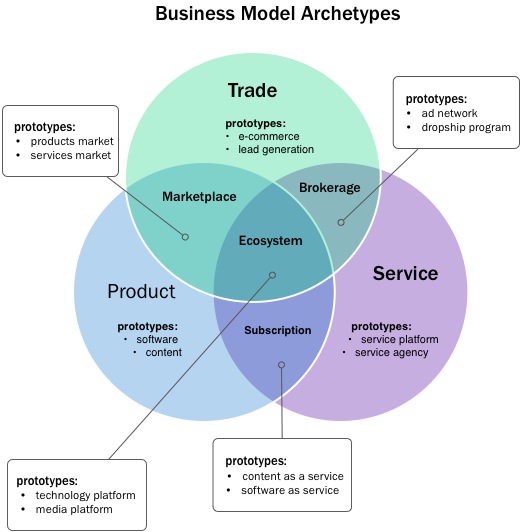The purpose of a business model is to concisely describe the function of your business within the overall market landscape. This includes details such as business inputs and dependencies, target customer base and the value being created on behalf of those customers. By using such a conceptual construct for evaluating a business, strategists are able to more easily understand the function of the business, as well as identify strengths, weaknesses and opportunities by comparing the attributes of other similar businesses which may use a similar structural model.
While the concept is great, the value of such an exercise is lost on many product managers, who require something a bit more compact and immediately usable. There is a growing library of popular models that go by names like ‘razor and blades’ and ‘network effects business’. These describe popular models that have been successfully used by other companies, but the knowledge is diffuse and there is little organization or context from which to easily discover and compare model options that may be appropriate for a business. The net result is that unless you have formally studied business strategy, there’s a good chance you are not aware of these known models and thus the wisdom they represent is not leveraged. It is critical, however, for product managers to clearly articulate the function and contact of their business in the market.
It was with this challenge in mind that a different approach was developed, called ‘business model archetypes’. The concept is derived from work by Carl Jung, the 20th century psychiatrist who suggested there are fundamental personality templates from which we all inherit and combine attributes to create our own personalities. By understanding the fundamental templates he believed, you could better understand the personality of an individual and predict their response to a variety of stimulus. He called this theory, personality archetypes.
Jung’s concept is also relevant to the fundamental personalities of a business and provides an excellent structural base from which to identify the spectrum of possible templates. There are three primary personalities that describe the fundamental interests and activities of every business. And, similar to an additive colour wheel, three secondary archetypes are derived by combining attributes of the three primary archetypes:
Primary
• Product – one-time purchase of an artifact
• Service – manually doing something and charging a fee
• Trade – connecting buyers and sellers for commerce
Secondary
• Brokerage – providing trade as a service
• Subscription – productizing and semi-automating a service
• Marketplace – productizing trade with a self-service platform
• Ecosystem – platform others build businesses around (combines all three)

Image excerpted from The Smarter Startup by Neal Cabage and Sonya Zhang. Copyright © 2013. Used with permission of Pearson Education, Inc. and New Riders
These seven archetypes are high-level abstractions that describe basic truths about categories of businesses. This can be helpful for identifying a generalized context from which to determine where in the spectrum of possibilities to focus your efforts, but it is not specific enough to be actionable. For this, two prototypes were added to each of the model archetypes. A prototype is a more specific and functional demonstration of what is possible within a model archetype.
To demonstrate this idea, the ‘trade archetype’ has two prototype examples: e-commerce and lead generation. Both are examples of sourcing something of value and bringing it to the market for sale. In both cases, money is made on the spread between the cost of acquiring the item and what it can be sold for by the trader by taking it to market and promoting it. Similarly, software and content are the two most common types of products to sell if you are an online business.
Being able to see the spectrum of structural options is a great place to begin thinking through the strategy of your business. Typically, teams will find they relate more strongly to one of the archetypes than the others, but while evaluating their options more closely, they might be able to reasonably pivot to the neighbouring archetypes, providing additional opportunity and potentially an even more innovative and effective approach to their business. A well-connected ‘trader’ for example might find interest in expanding their business through a brokerage model by providing dropship fulfilment of their products. Or they may be interested in building a category-leading brand online by establishing the go-to marketplace for the types of products they specialize in.
The important point is to take the time to do the analysis and to understand the primary function of your business and to consider the possible variations on your theme that might be more optimal that what you’re currently doing. That is where the business model archetypes framework is useful, by providing a conceptual framework with which to think through the possible opportunities you may not have considered. At the end of the day, every product manager should be able to clearly articulate their business’s foundational strategy and to understand their context and expansion and pivot options. This framework provides a simplified method for achieving these goals.






Comments 1